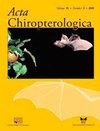Forecasting the Distribution of a Range-Expanding Bat Reveals Future Response to Climate Change and Habitat
IF 0.7
4区 生物学
Q4 ZOOLOGY
引用次数: 3
Abstract
Many terrestrial vertebrate species are exhibiting geographic distribution changes including poleward range limit shifts in response to increases in regional temperature. Bats are a highly mobile taxa capable of rapid responses to changes in abiotic or biotic conditions. In North America, recent extralimital records of the non-hibernating Lasiurus seminolus (Seminole bat) have been attributed to climate change, however such attributions remain speculative and potentially subject to sampling bias in the form of increased recent sampling efforts at latitudes north of the historical range. We used historical occurrence records and simple environmental variables within a Maxent modeling framework to model the historical distribution of suitable areas for this species. We transferred the model using near current environmental conditions and measured the ability of the model to capture the apparent expansion in distribution using recent extralimital occurrence records. Our model transferred well over time concluding that the distribution expansion may be largely attributed to increasing minimum temperatures. We used the model to forecast the expansion in distribution of suitable areas at three 20-year intervals and various climate change scenarios and provide extrapolation risk maps for each scenario. Although increasing temperatures may increase potentially occupiable areas, the species is associated with forests and often roosts in pines (Pinus spp.). This suitable habitat is more limited to the northwest of the species' range, which may constrain the future species expansion despite favorable temperatures. We demonstrated this effect by mapping limiting factors through future climate change scenarios. We discovered a broad shift of effects that constrained the distribution from minimum temperature to an abundance metric of evergreen cover type as time and climate change intensity increased. Although uncertainties exist, we predict further expansion of the Seminole bat widely over the next 60 years across the eastern United States where suitable habitat and climate conditions converge. Our results appear consistent with other bat species showing similar range extensions and in turn provide further evidence that bats may serve as bioindicators of global change.预测扩展范围的蝙蝠的分布揭示了未来对气候变化和栖息地的反应
许多陆生脊椎动物物种表现出地理分布的变化,包括随着区域温度的升高而向极地移动的范围限制。蝙蝠是一种高度流动的类群,能够对非生物或生物条件的变化做出快速反应。在北美洲,最近对非冬眠的细尾蝙蝠(塞米诺尔蝙蝠)的超极限记录被归因于气候变化,但这种归因仍然是推测性的,可能会受到采样偏差的影响,因为最近在历史范围以北的纬度地区增加了采样工作。我们在Maxent建模框架内使用历史发生记录和简单的环境变量来建模该物种适宜区域的历史分布。我们使用近当前环境条件转移了模型,并使用最近的超极限发生记录测量了模型捕捉分布明显扩展的能力。我们的模型随着时间的推移进行了很好的转换,得出的结论是分布膨胀可能在很大程度上归因于最低温度的升高。我们使用该模型预测了三个20年间隔和各种气候变化情景下合适区域分布的扩展,并为每种情景提供了外推风险图。尽管气温升高可能会增加潜在的可占用面积,但该物种与森林有关,通常栖息在松树(Pinus spp.)中。这种合适的栖息地更局限于该物种范围的西北部,尽管气温有利,但这可能会限制未来物种的扩张。我们通过绘制未来气候变化情景中的限制因素来证明这种影响。我们发现,随着时间和气候变化强度的增加,影响从最低温度到常绿覆盖类型丰度指标的分布发生了广泛的变化。尽管存在不确定性,但我们预测,在未来60年内,塞米诺尔蝙蝠将在美国东部广泛扩张,那里有合适的栖息地和气候条件。我们的研究结果似乎与其他表现出类似范围扩展的蝙蝠物种一致,这反过来又提供了进一步的证据,证明蝙蝠可能是全球变化的生物指标。
本文章由计算机程序翻译,如有差异,请以英文原文为准。
求助全文
约1分钟内获得全文
求助全文
来源期刊

Acta Chiropterologica
生物-动物学
CiteScore
2.50
自引率
20.00%
发文量
42
审稿时长
>12 weeks
期刊介绍:
Acta Chiropterologica, published by the Museum and Institute of Zoology at the Polish Academy of Sciences, is devoted solely to the study and discussion of bats.
 求助内容:
求助内容: 应助结果提醒方式:
应助结果提醒方式:


